-
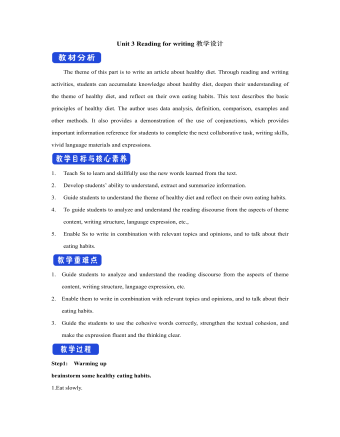
新人教版高中英语选修2Unit 3 Reading for writing教学设计
The theme of this part is to write an article about healthy diet. Through reading and writing activities, students can accumulate knowledge about healthy diet, deepen their understanding of the theme of healthy diet, and reflect on their own eating habits. This text describes the basic principles of healthy diet. The author uses data analysis, definition, comparison, examples and other methods. It also provides a demonstration of the use of conjunctions, which provides important information reference for students to complete the next collaborative task, writing skills, vivid language materials and expressions.1. Teach Ss to learn and skillfully use the new words learned from the text.2. Develop students’ ability to understand, extract and summarize information.3. Guide students to understand the theme of healthy diet and reflect on their own eating habits.4. To guide students to analyze and understand the reading discourse from the aspects of theme content, writing structure, language expression, etc., 5. Enable Ss to write in combination with relevant topics and opinions, and to talk about their eating habits.1. Guide students to analyze and understand the reading discourse from the aspects of theme content, writing structure, language expression, etc.2. Enable them to write in combination with relevant topics and opinions, and to talk about their eating habits.3. Guide the students to use the cohesive words correctly, strengthen the textual cohesion, and make the expression fluent and the thinking clear.Step1: Warming upbrainstorm some healthy eating habits.1.Eat slowly.2.Don’t eat too much fat or sugar.3.Eat healthy food.4.Have a balanced diet.Step2: Read the passage and then sum up the main idea of each paragraph.
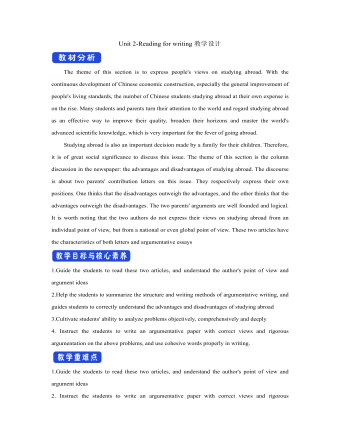
新人教版高中英语选修2Unit 2 Reading for writing教学设计
The theme of this section is to express people's views on studying abroad. With the continuous development of Chinese economic construction, especially the general improvement of people's living standards, the number of Chinese students studying abroad at their own expense is on the rise. Many students and parents turn their attention to the world and regard studying abroad as an effective way to improve their quality, broaden their horizons and master the world's advanced scientific knowledge, which is very important for the fever of going abroad. Studying abroad is also an important decision made by a family for their children. Therefore, it is of great social significance to discuss this issue. The theme of this section is the column discussion in the newspaper: the advantages and disadvantages of studying abroad. The discourse is about two parents' contribution letters on this issue. They respectively express their own positions. One thinks that the disadvantages outweigh the advantages, and the other thinks that the advantages outweigh the disadvantages. The two parents' arguments are well founded and logical. It is worth noting that the two authors do not express their views on studying abroad from an individual point of view, but from a national or even global point of view. These two articles have the characteristics of both letters and argumentative essays1.Guide the students to read these two articles, and understand the author's point of view and argument ideas2.Help the students to summarize the structure and writing methods of argumentative writing, and guides students to correctly understand the advantages and disadvantages of studying abroad3.Cultivate students' ability to analyze problems objectively, comprehensively and deeply
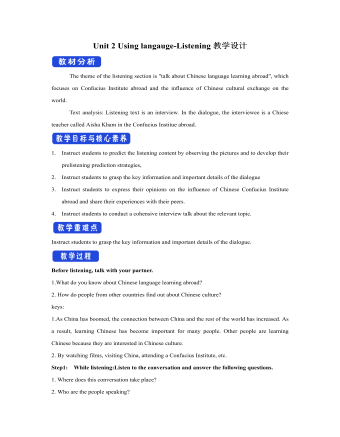
新人教版高中英语选修2Unit 2 Using langauge-Listening教学设计
? B: Absolutely! Getting involved with Chinese cultural activities there definitely helped a lot. I got to practice my Chinese on a daily basis, and I could learn how native Chinese speakers spoke.? A: What do you feel is your biggest achievement?? B: Learning Chinese characters! I have learnt about 1,500 so far. When I first started, I didn't think it was even going to be possible to learn so many, but now I find that I can read signs, menus, and even some easy newspaper articles.? A: What are you most keen on?? B: I've really become keen on learning more about the Chinese culture, in particular Chinese calligraphy. As I have learnt Chinese characters, I have developed a great appreciation for their meaning. I want to explore Chinese characters by learning how to write them in a more beautiful way. ? A: Finally, what do you want to say to anyone interested in learning Chinese?? I have really become keen on learning more about the Chinese culture, in particular Chinese Calligraphy. As I have learnt Chinese character, I have developed a great appreciation for their meaning. I want to explore Chinese characters by learning how to write them in a more beautiful way.? A: Finally, what do you want to say to anyone interested in learning Chinese?? B: I'd say, give it a shot! While some aspects may be difficult, it is quite rewarding and you will be happy that you tried.? A: Thanks for your time. ? B:You're welcome.

新人教版高中英语选修2Unit 3 Using langauge-Listening教学设计
1. How is Hunan cuisine somewhat different from Sichuan cuisine?The heat in Sichuan cuisine comes from chilies and Sichuan peppercorns. Human cuisine is often hotter and the heat comes from just chilies.2.What are the reasons why Hunan people like spicy food?Because they are a bold people. But many Chinese people think that hot food helps them overcome the effects of rainy or wet weather.3.Why do so many people love steamed fish head covered with chilies?People love it because the meat is quite tender and there are very few small bones.4.Why does Tingting recommend bridge tofu instead of dry pot duck with golden buns?Because bridge tofu has a lighter taste.5 .Why is red braised pork the most famous dish?Because Chairman Mao was from Hunan, and this was his favorite food.Step 5: Instruct students to make a short presentation to the class about your choice. Use the example and useful phrases below to help them.? In groups of three, discuss what types of restaurant you would like to take a foreign visitor to, and why. Then take turns role-playing taking your foreign guest to the restaurant you have chosen. One of you should act as the foreign guest, one as the Chinese host, and one as the waiter or waitress. You may start like this:? EXAMPLE? A: I really love spicy food, so what dish would you recommend?? B: I suggest Mapo tofu.? A: Really ? what's that?

新人教版高中英语选修2Unit 4 Learning about Language教学设计
This section guides students to pay attention to the typical context of vocabulary use, helps students accumulate vocabulary around the key vocabulary of this unit, and uses the learned words and word chunks in different contexts to deeply understand their meaning and usage, so as to achieve the purpose of review and consolidation.The teaching design activities aim to guide students to pay attention to the typical context in which the target vocabulary is used, as well as the common vocabulary used in collocation, so that students can complete the sentence with correct words. In terms of vocabulary learning strategies, this unit focuses on cultivating students' ability to pay attention to collocation of words and to use word blocks to express meaning.For vocabulary learning, it is not enough just to know the meaning of a single word, but the most important thing is to master the common collocations of words, namely word blocks.Teachers should timely guide students to summarize common vocabulary collocation, such as verb and noun collocation, verb and preposition collocation, preposition and noun collocation, and so on.1. Guide students to understand and consolidate the meaning and usage of the vocabulary in the context, 2. Guide the students to use the unit topic vocabulary in a richer context3. Let the students sort out and accumulate the accumulated vocabulary, establishes the semantic connection between the vocabulary,4. Enable students to understand and master the vocabulary more effectivelyGuiding the Ss to use unit topic words and the sentence patterns in a richer context.

新人教版高中英语选修2Unit 4 Reading for writing教学设计
假定你是英国的Jack,打算来中国旅行,请你给你的中国笔友李华写一封信,要点如下:1.你的旅行计划:北京→泰山→杭州;2.征求建议并询问他是否愿意充当你的导游。注意:1.词数80左右(开头和结尾已给出,不计入总词数);2.可以适当增加细节,以使行文连贯。参考词汇:故宫 the Forbidden City;泰山 Mount TaiDear Li Hua,I'm glad to tell you that 'm going to visit China.First,I am planning to visit Beijing,the capitalof China,where I am looking forward to enjoying the Great Wall,the Forbidden City and somebeautiful parks.Then I intend to go to visit Mount Tai in Shandong Province.I've heard that it is one ofthe most famous mountains in China and I can't wait to enjoy the amazing sunrise there.After that,I amalso going to Hangzhou.It is said that it is a beautiful modern city with breathtaking natural sights,among which the West Lake is a well- known tourist attraction.What do you think of my travel plan? Will you act as my guide? Hope to hear from you soon.

新人教版高中英语选修2Unit 4 Using langauge-Listening教学设计
The theme of the listening section is " talking about scenery and culture along a journey."The part is designed to further lead the students to understand Canadian natural geography and social environment, and integrated into the cultural contrast by mentioning the long train journey from Beijing to Moscow routes. On this basis, the part activates students related travel experience, lets the student serial dialogue, guides the student to explore further the pleasure and meaning of the long journey, and Chinese and foreign cultural comparison.The part also provides a framework for the continuation of the dialogue, which is designed to provide a framework for students to successfully complete their oral expressions, and to incorporate an important trading strategy to end the dialogue naturally.1. Help students to understand and master some common English idioms in the context, and experience the expression effect of English idioms.2. Guide the students to understand the identity of different people in the listening context, and finish the dialogue according to their own experience.3. Instruct the students to use appropriate language to express surprise and curiosity about space and place in the dialogue, and master the oral strategy of ending the dialogue naturally.1. Instruct students to grasp the key information and important details of the dialogue.2. Instruct students to conduct a similar talk on the relevant topic.

人教版高中语文必修3《劝学》教案2篇
五.研习第一段:1.诵读指导要处理好句中停顿2.请学生对照注释翻译本段重点词句:学不可以已已:停止。青,取之于蓝而青于蓝于:从;比。木直中绳中:zhàng符合,合于。虽有槁暴,不复挺者,揉使之然也有通又,揉通煣,以火烘木,使其弯曲。然:这样。翻译:故木受绳则直,金就砺则利,君子博学而日参省乎己,则知明而行无过矣。所以木材经墨线画过(再用斧锯加工)就直了,金属刀剑拿到磨刀石上(磨过)就锋利了,君子广博地学习并且每天对自己检验反省,就能智慧明达,行为没有过错了。3.本段是从哪个角度论述中心论点的?明确:本段是从学习的意义这个角度论述中心论点的。荀子认为人的知识、道德、才能都不是天生成的,而是后天不断学习获得的,学习的意义十分重大,所以学习不能停止。4.本段中几个比喻句是为了说明什么道理?学生讨论发言,教师明确:

人教版高中历史必修3文学的繁荣教案3篇
苏联文学的沿革,既反映了苏联社会的伟大思想性变革,又反映了苏联文坛活跃与混乱并存的局面,特别是其所具有强烈的意识形态色彩是苏联社会深层次变化的风向标。(2)20世纪的亚、非、拉美文学20世纪亚、非、拉美文学的繁荣伴随着民族民主运动的高涨,其主流都体现了反对殖民压迫、反对社会不公的爱国主义精神。出现了许多颇有影响的作家和作品。泰戈尔是印度近现代文学的光辉代表,为印度现代民族主义奠定了基础。其代表作《戈拉》塑造了爱国的印度民族主义知识分子形象。泰戈尔是首位获诺贝尔文学奖的东方作家。鲁迅是中国文学革命的巨匠,他的《呐喊》集,昭示着中国新文学时代的到来。哥伦比亚作家马尔克斯的《百年孤独》,描绘加勒比海沿岸小城百年孤独的原因及打破这种状态的途径。
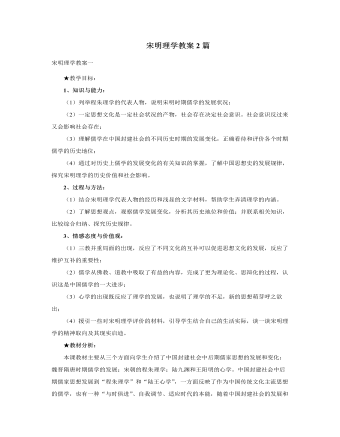
人教版高中历史必修3宋明理学教案2篇
二、程朱理学:1、宋代“理学”的产生:(1)含义:所谓“理学”,就是用“理学”一词来指明当时两宋时期所呈现出来的儒学。广义的理学,泛指以讨论天道问题为中心的整个哲学思潮,包括各种不同的学派;狭义的理学,专指程颢、程颐、朱熹为代表的,以“理”为最高范畴的学说,称为“程朱理学”。理学是北宋政治、社会、经济发展的理论表现,是中国古代哲学长期发展的结果,是批判佛、道学说的产物。他们把“理”或“天理”视作哲学的最高范畴,认为理无所不在,不生不灭,不仅是世界的本原,也是社会生活的最高准则。在穷理方法上,程颢“主静”,强调“正心诚意”;程颐“主敬”,强调“格物致知”。在人性论上,二程主张“去人欲,存天理”,并深入阐释这一观点使之更加系统化。二程学说的出现,标志着宋代“理学”思想体系的正式形成。【合作探究】宋代“理学”兴起的社会条件:
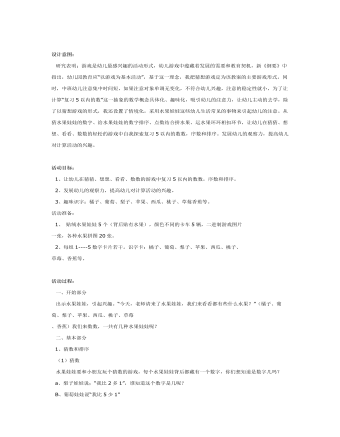
中班数学:计算活动:我猜,我猜,我猜猜猜课件教案
活动目标: 1、让幼儿在猜猜、想想、看看、数数的游戏中复习5以内的数数,序数和排序。 2、发展幼儿的观察力,提高幼儿对计算活动的兴趣。 3、趣味识字:橘子、葡萄、梨子、苹果、西瓜、桃子、草莓香蕉等。活动准备: 1、贴绒水果娃娃5个(背后贴有水果),颜色不同的卡车5辆,二进制游戏图片一张,各种水果拼图20张。 2、每组1----5数字卡片若干。识字卡:橘子、葡萄、梨子、苹果、西瓜、桃子、草莓、香蕉等。 活动过程: 一、开始部分 出示水果娃娃,引起兴趣。“今天,老师请来了水果娃娃,我们来看看都有些什么水果?”(橘子、葡萄、梨子、苹果、西瓜、桃子、草莓、香蕉)我们来数数,一共有几种水果娃娃呢? 二、基本部分 1、猜数和排序 (1)猜数 水果娃娃要和小朋友玩个猜数的游戏,每个水果娃娃背后都藏有一个数字,你们想知道是数字几吗? a、梨子娃娃说;“我比2多1”,谁知道这个数字是几呢? B、葡萄娃娃说“我比5少1” C、橘子娃娃说“我是1-----5数字中最小的那个数,是数字几呢? D、你们看看1----5数字中还剩下哪两个数呢?那西瓜娃娃和苹果娃娃谁是2谁是5呢?西瓜娃娃说:“我的数字比苹果娃娃大,谁能告诉大家是几?那苹果娃娃是数 字几? (2)巩固 现在老师看看你们记住了没有,加以验证。师指认每个水果娃娃,让幼儿说出背后的数字。 (3)猜猜少了哪个数? 现在老师任意拿走一样水果,问少了几,是什么水果,重复指认水果和数字。
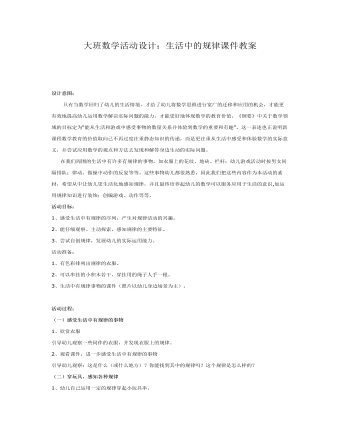
大班数学活动设计:生活中的规律课件教案
活动目标:1、感受生活中有规律的序列,产生对规律活动的兴趣。2、能仔细观察、主动探索,感知规律的主要特征。3、尝试自创规律,发展幼儿的实际运用能力。活动准备:1、有色彩排列出规律的衣服。2、可以串挂的小积木若干,穿挂用的绳子人手一根。3、生活中有规律事物的课件(照片以幼儿身边场景为主)。
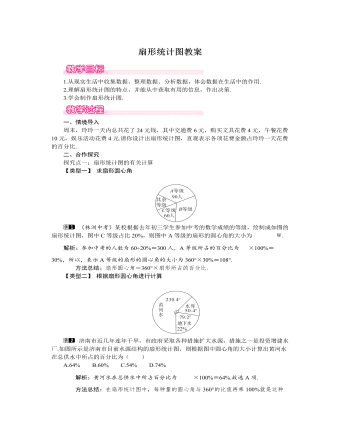
北师大初中七年级数学上册扇形统计图教案1
根据题意,得34%x-18%x=160,解得x=1000.所以48%x=48%×1000=480(公顷),18%x=18%×1000=180(公顷),34%x=34%×1000=340(公顷).答:玉米种了340公顷,高粱种了180公顷,水稻种了480公顷.方法总结:从扇形统计图中获取正确的信息是解题的关键.语文老师对班上学生的课外阅读情况做了调查,并请数学老师制作了如图所示的统计图.(1)哪种书籍最受欢迎?(2)哪两种书籍受欢迎程度差不多?(3)图中扇形分别表示什么?(4)图中的各个百分比如何得到?所有的百分比之和是多少?解:(1)科幻书籍最受欢迎,可从扇形的大小或图中百分比的大小得出.(2)科普书籍和武侠书籍受欢迎程度差不多,可从图中扇形大小或图中所标百分比的大小得出.(3)图中扇形分别代表了最喜欢某种书籍的人数占全班人数的百分比.(4)用最喜欢某种书籍的人数比全班的总人数即可得各个百分比,所有的百分比之和为1.方法总结:由扇形统计图获取信息时,一定要明确各个项目和它们所占圆面的百分比.
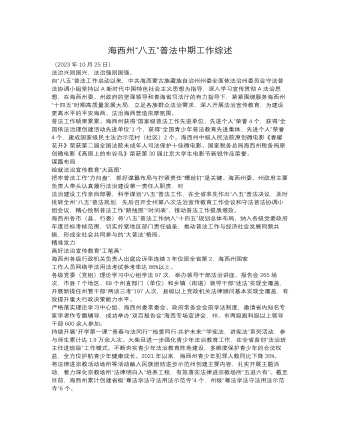
海西州“八五”普法中期工作综述
优化基层法律服务供给,率先挂牌运行四级社会治理综合服务中心,实现公共法律服务实体平台、“一村一法律顾问”全覆盖。深入实施乡村(社区)“法律明白人”“十百千”培育工程,依托公共法律服务站(室)、社会矛盾调处“一站式”服务中心,将普法融入法律服务和排查、化解矛盾纠纷各环节,打通法治宣传“最后一公里”。“掌上普法”“语音普法”“指尖普法”步入常态,有效整合地方网络媒体资源,积极发挥网络平台优势,以云课堂、微讲堂、线上谈等形式,持续开展线上普法活动。“海西州普法”公众号影响力稳居全省司法行政系统新媒体榜前列,“德令哈普法”视频号、抖音号持续推送民法典系列原创视频110期,阅读量达58.1万余次,“都兰法院”“德令哈警视”等平台开设蒙古、藏、汉三语普法栏目,用通俗易懂的语言、鲜活生动的事例,全方位、多角度开展普法宣传。走进海西州,法治的春风扑面而来,普法的春雨润物无声。一幅幅和谐的优美画卷,一个个平安有序、文明美好的景象,让人真切地感受到“八五”普法给群众带来的获得感、幸福感、安全感。
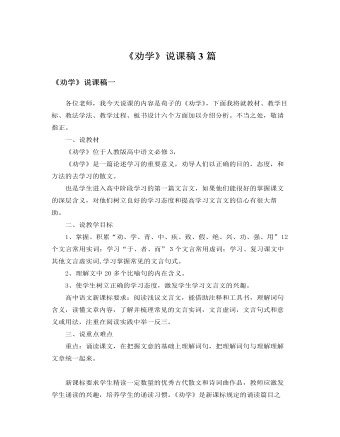
人教版高中语文必修3《劝学》说课稿3篇
《劝学》是普通高中课程标准试验教科书语文必修三第三单元的重点篇目,该文集中反映著名思想家荀子在学习问题上的观点和精彩斐然的论证艺术。该单元所选课文都是古代的议论性散文。通过本单元的学习在于让学生感受我国传统文化的精神,掌握基础的文言语法知识,学习如何清晰有力的表达自己的思想和见解。本文安排在单元的第一篇,如何指导学生学好这篇课文,是实现“授之以渔”,树立学生学好文言文的信心,掌握文言学习方法的关键。根据新课标倡导从“知识与能力”、“过程与方法”、“情感态度与价值观”三方面出发设计课程目标的要求和高一的学生对于文言文的知识还在积累的阶段,应该注重基础知识的积累和一定量的诵读的实际情况。我拟确定以下教学目标:1,了解荀子论述学习的思想,明确学习要靠积累、坚持不懈、专心致志的道理。2,掌握积累文言实词、虚词,活用、古今异议等现象和固定句式。

人教版高中历史必修3宋明理学说课稿3篇
陆王心学与程朱理学相比有何异同?生 不同点:在理的内涵上不同,程朱理学认为“理”是贯通于宇宙、人伦的客观存在,是一种普遍的规律准则;陆王心学认为心即理,是“良知”,认为人心便是世界万物的本原。方法上也有不同:前者向外追究,“格物致知”;后者向内探求,“发明本心”以求理,克服私欲、回复良知。生 相同点:都提出了一个宇宙、社会、人生遵循的“理”。师 对。程朱理学是客观唯心主义,阳明心学是主观唯心主义。这两者的分歧是理学范围内的分歧,其基本思想是一致的。师 宋明理学与汉唐以前的儒学比较,最大的特点在于批判地吸收了佛教哲学的思辨结构和道教的宇宙生成论,将儒家的伦理学说概括升华为哲学基本问题。其实质是把佛、道“养性”“修身”引向儒家的“齐家”“治国”“平天下”,对儒家的纲常道德给予哲学论证,使之神圣化、绝对化、普遍化,以便深入人心,做到人人遵而行之。
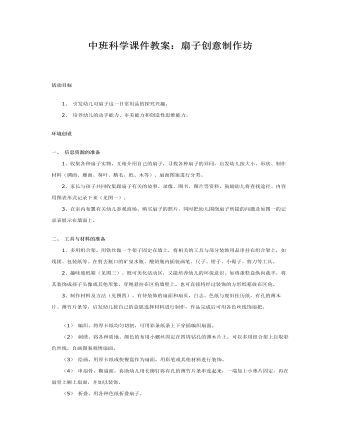
中班科学课件教案:扇子创意制作坊
2、培养幼儿的动手能力、审美能力和创造性思维能力。环境创设一、信息资源的准备1、收集各种扇子实物,互相介绍自己的扇子,寻找各种扇子的异同,启发幼儿按大小、形状、制作材料(绸面、藤面、葵叶、鹅毛、纸、木等)、扇面图案进行分类。2、家长与孩子共同收集跟扇子有关的故事、录像、图书、图片等资料,鼓励幼儿将查找途径、内容用图表形式记录下来(见图一)。3、在室内布置有关幼儿参观商场、购买扇子的照片,同时把幼儿围绕扇子所提的问题及如图一的记录表展示在墙面上。二、工具与材料的准备1、多用组合架。用铁丝做一个架子固定在墙上,将相关的工具与部分装饰用品串挂在组合架上,如线团、包装纸等。在剪去瓶口的矿泉水瓶、酸奶瓶内插装画笔、尺子、钳子、小锯子、剪刀等工具。2、趣味废纸箱(见图三)。既可美化活动区,又能培养幼儿的环保意识。如将蛋糕盒纵向裁半,将其装饰成孩子头像或其他形象,穿绳悬挂在区角墙壁上。也可直接将经过装饰的方形纸箱放在区角。3、制作材料及方法(见图四)。有待装饰的扇面和扇页,白志、色纸与废旧挂历纸,有孔的薄木片、薄竹片条等,启发幼儿按自己的意愿选择材料进行制作,作品完成后可用各色丝线饰扇把。
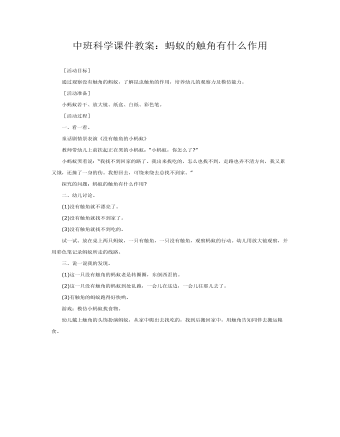
中班科学课件教案:蚂蚁的触角有什么作用
[活动准备] 小蚂蚁若干、放大镜、纸盒、白纸、彩色笔。 [活动过程] 一、看一看。 童话剧情景表演《没有触角的小蚂蚁》 教师带幼儿上前扶起正在哭的小蚂蚁:“小蚂蚁,你怎么了?” 小蚂蚁哭着说:“我找不到回家的路了。我出来找吃的,怎么也找不到,走路也弄不清方向,我又累又饿,还撞了一身的伤。我想回去,可绕来绕去总找不到家。” 探究的问题:蚂蚁的触角有什么作用? 二、幼儿讨论。(1)没有触角就不漂亮了。(2)没有触角就找不到家了。

北师大初中七年级数学下册用尺规作角教案
解析:①以O为圆心,任意长为半径作弧交OA于D,交OB于C;②以O′为圆心,以同样长(OC长)为半径作弧,交O′B′于C′;③以C′为圆心,CD长为半径作弧交前弧于D′;④过D′作射线O′A′,∠A′O′B′为所求.解:如下图所示.【类型三】 利用尺规作角的和或差已知∠AOB,用尺规作图法作∠A′O′B′,使∠A′O′B′=2∠AOB.解析:先作一个角等于∠AOB,再以这个角的一边为边在其外部作一个角等于∠AOB,那么图中最大的角就是所求的角.解:作法:①作∠DO′B′=∠AOB;②在∠DO′B′的外部作∠A′O′D=∠AOB,∠A′O′B′就是所求的角(如下图).三、板书设计1.尺规作图2.用尺规作角本节课学习了有关尺规作图的相关知识,课堂教学内容以学生动手操作为主,在学生动手操作的过程中要鼓励学生大胆动手,培养学生的动手能力和书面语言表达能力
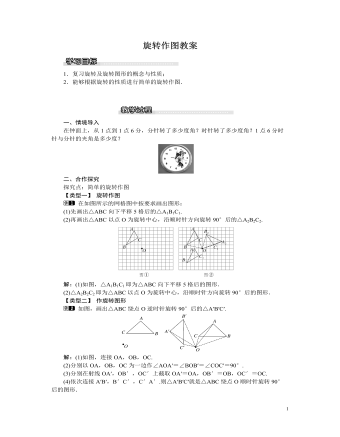
北师大初中八年级数学下册旋转作图教案
解析:整个阴影部分比较复杂和分散,像此类问题通常使用割补法来计算.连接BD、AC,由正方形的对称性可知,AC与BD必交于点O,正好把左下角的阴影部分分成(Ⅰ)与(Ⅱ)两部分(如图②),把阴影部分(Ⅰ)绕点O逆时针旋转90°至阴影部分①处,把阴影部分(Ⅱ)绕点O顺时针旋转90°至阴影部分②处,使整个阴影部分割补成半个正方形.解:如图②,把阴影部分(Ⅰ)绕点O逆时针旋转90°至阴影部分①处,把阴影部分(Ⅱ)绕点O顺时针旋转90°至阴影部分②处,使原阴影部分变为如图②的阴影部分,即正方形的一半,故阴影部分面积为12×10×10=50(cm2).方法总结:本题是利用旋转的特征:旋转前、后图形的形状和大小不变,把图形利用割补法补全为一个面积可以计算的规则图形.三、板书设计1.简单的旋转作图2.旋转图形的应用教学过程中,强调学生自主探索和合作交流,经历观察、归纳和动手操作,利用旋转的性质作图.
